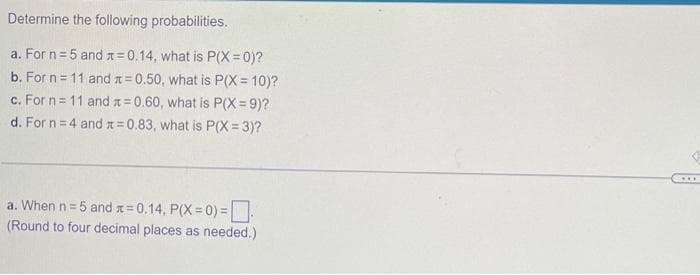Determine the following probabilities. a. For n=5 and x=0.14, what is P(X=0)? b. For n = 11 and =0.50, what is P(X = 10)? c. For n = 11 and x=0.60, what is P(X= 9)? d. For n=4 and x=0.83, what is P(X= 3)? a. When n=5 and x = 0.14, P(X=0) = (Round to four decimal places as needed.)
Determine the following probabilities. a. For n=5 and x=0.14, what is P(X=0)? b. For n = 11 and =0.50, what is P(X = 10)? c. For n = 11 and x=0.60, what is P(X= 9)? d. For n=4 and x=0.83, what is P(X= 3)? a. When n=5 and x = 0.14, P(X=0) = (Round to four decimal places as needed.)
College Algebra
7th Edition
ISBN:9781305115545
Author:James Stewart, Lothar Redlin, Saleem Watson
Publisher:James Stewart, Lothar Redlin, Saleem Watson
Chapter9: Counting And Probability
Section9.2: Probability
Problem 31E
Related questions
Question

Transcribed Image Text:Determine the following probabilities.
a. For n=5 and x=0.14, what is P(X=0)?
b. For n = 11 and =0.50, what is P(X= 10)?
c. For n = 11 and x = 0.60, what is P(X= 9)?
d. For n=4 and x=0.83, what is P(X= 3)?
a. When n = 5 and x = 0.14, P(X=0)=
(Round to four decimal places as needed.)
www.
Expert Solution
This question has been solved!
Explore an expertly crafted, step-by-step solution for a thorough understanding of key concepts.
Step by step
Solved in 2 steps with 2 images

Recommended textbooks for you

College Algebra
Algebra
ISBN:
9781305115545
Author:
James Stewart, Lothar Redlin, Saleem Watson
Publisher:
Cengage Learning

College Algebra
Algebra
ISBN:
9781305115545
Author:
James Stewart, Lothar Redlin, Saleem Watson
Publisher:
Cengage Learning